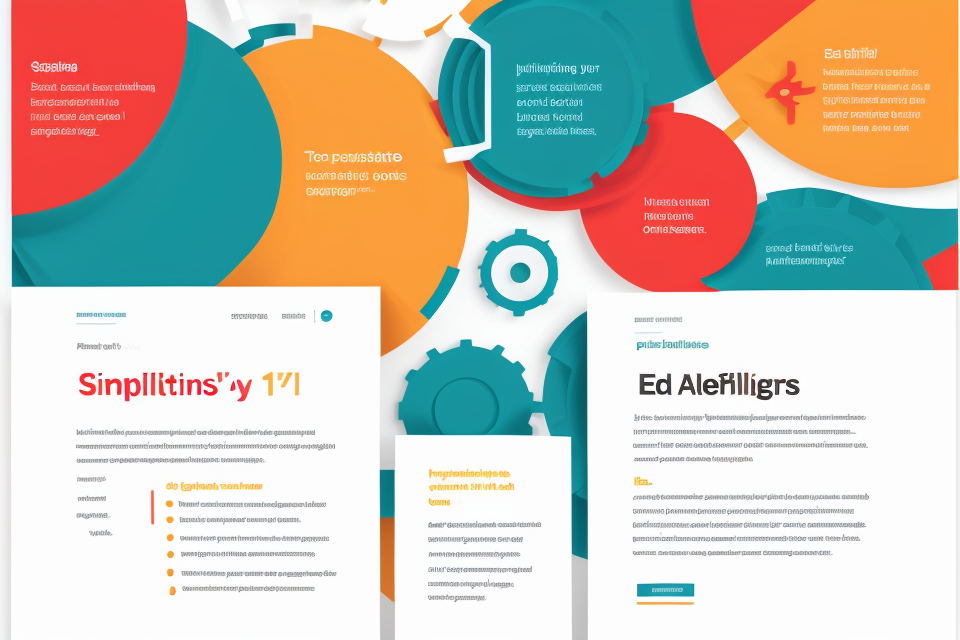
In the world of software development, performance optimization is a crucial aspect that can make or break an application. It refers to the process of improving the speed, efficiency, and responsiveness of a software program by identifying and eliminating bottlenecks, reducing memory usage, and optimizing resource allocation. This comprehensive guide will delve into various optimization techniques, tools, and best practices that can help developers maximize the performance of their software applications. From code profiling and memory management to caching and parallel processing, this guide will cover it all. Get ready to take your software performance to the next level!
Understanding Software Performance Optimization
Why is software performance optimization important?
Software performance optimization is a crucial aspect of software development that should not be overlooked. It is the process of improving the efficiency and effectiveness of software systems by identifying and addressing performance bottlenecks. Here are some reasons why software performance optimization is important:
- Improved user experience: When software is optimized, it can provide a better user experience. Users expect software to be fast and responsive, and performance optimization helps achieve this goal. By reducing latency and improving system performance, users can access the information they need more quickly, resulting in a more positive user experience.
- Increased productivity: Performance optimization can also increase productivity. When software is slow or unresponsive, users may become frustrated and take longer to complete tasks. By optimizing software performance, users can work more efficiently, saving time and increasing productivity.
- Cost savings: Performance optimization can also result in cost savings. When software is slow or unresponsive, it can lead to increased server usage, increased storage costs, and increased maintenance costs. By optimizing software performance, these costs can be reduced, resulting in significant cost savings over time.
Overall, software performance optimization is important because it can improve the user experience, increase productivity, and result in cost savings. By taking the time to optimize software performance, developers can create systems that are more efficient, effective, and cost-effective.
What are the challenges of software performance optimization?
- Identifying bottlenecks: One of the primary challenges in software performance optimization is identifying the bottlenecks that are hindering the application’s performance. Bottlenecks can occur in various areas of the application, such as the database, the server, or the network. Identifying these bottlenecks requires a deep understanding of the application’s architecture and its interactions with other components.
- Balancing performance with other factors: Another challenge in software performance optimization is balancing performance with other factors such as security, maintainability, and scalability. For example, optimizing the application for speed may compromise security, while optimizing for security may impact performance. It is crucial to strike a balance between these factors to ensure that the application meets the user’s requirements and expectations.
- Keeping up with technology advancements: Finally, software performance optimization is an ever-evolving field that requires constant updates and improvements. New technologies and methodologies are constantly emerging, and it can be challenging to keep up with these advancements and integrate them into the application’s architecture. Therefore, it is essential to stay up-to-date with the latest trends and developments in software performance optimization to ensure that the application remains competitive and efficient.
Identifying Performance Bottlenecks
What are the common causes of performance bottlenecks?
Performance bottlenecks are areas in a software system where the program’s efficiency is hindered, resulting in slower execution times. These bottlenecks can arise from various sources, which can be broadly categorized into three main categories:
- Inefficient algorithms: An algorithm is a set of rules and instructions that a computer program follows to solve a problem. If an algorithm is not optimized for the specific problem it is trying to solve, it can lead to slower execution times. For example, an inefficient sorting algorithm can take much longer to sort a large dataset than a more efficient algorithm like quicksort.
- Resource contention: Resource contention occurs when multiple processes or threads are competing for the same limited resources, such as CPU time, memory, or disk space. This can lead to slower performance as each process may be limited by the resources it can access. For example, if multiple processes are accessing the same database, they may all be competing for the same limited resources, leading to slower performance.
- Poorly optimized code: Code that is not optimized can lead to slower performance as it may contain inefficiencies that can be addressed through better coding practices. For example, using too many nested loops or inefficient data structures can lead to slower performance.
It is important to identify the root cause of performance bottlenecks in order to effectively optimize the software system. Once the cause has been identified, various optimization techniques can be employed to improve performance.
How can I identify performance bottlenecks in my software?
When it comes to identifying performance bottlenecks in your software, there are several techniques that you can use. Here are some of the most effective methods:
- Profiling tools:
Profiling tools are software tools that are designed to measure the performance of your software. These tools can help you identify which parts of your code are taking the most time to execute, and can also help you identify memory leaks and other performance issues. Some popular profiling tools include Visual Studio Profiler, Java VisualVM, and Gprof.
- Performance testing:
Performance testing is a technique that involves running your software under a variety of different loads and conditions to see how it performs. This can help you identify performance bottlenecks that might not be immediately apparent when running your software under normal conditions. Some popular performance testing tools include Apache JMeter, LoadRunner, and Gatling.
- Debugging techniques:
Debugging techniques involve using specialized tools and techniques to help you identify and fix bugs in your software. Some popular debugging tools include Eclipse IDE, Visual Studio, and IDA Pro.
By using these techniques, you can identify performance bottlenecks in your software and take steps to optimize it for better performance.
Optimizing Code for Performance
What are some common optimization techniques?
Caching
Caching is a technique that involves storing frequently accessed data in memory to avoid the overhead of computing it repeatedly. By storing the data, subsequent accesses can be performed much faster. Caching can be applied to various aspects of software performance, such as database queries, web page rendering, and image processing.
One popular caching technique is the use of memoization, which involves storing the results of a function call so that the next time the same inputs are provided, the cached result can be returned instead of recomputing the function. This can significantly reduce the computational overhead and improve performance.
Memory management
Memory management is an essential aspect of optimizing software performance. It involves managing the allocation and deallocation of memory to ensure that the program runs efficiently. Efficient memory management can prevent memory leaks, which can lead to poor performance and even crashing of the program.
One common technique for optimizing memory management is the use of smart pointers, which automatically manage the memory allocation and deallocation of objects. This can reduce the amount of manual memory management required and improve performance.
Loop unrolling
Loop unrolling is a technique that involves unrolling a loop, which means replacing the loop body with the loop’s result. This can significantly improve performance by reducing the overhead of the loop iteration.
For example, if a loop is executed many times, loop unrolling can replace the loop with the loop’s result, eliminating the need for the loop iteration and improving performance. This technique is particularly effective for small loops with a low number of iterations.
In conclusion, there are several common optimization techniques that can be applied to improve software performance. These techniques include caching, memory management, and loop unrolling. By applying these techniques, software developers can improve the performance of their applications and provide a better user experience.
How can I optimize my code for performance?
Optimizing code for performance is an essential aspect of software development. By following the right techniques, you can improve the speed and efficiency of your software. Here are some ways to optimize your code for performance:
- Identify and remove bottlenecks
A bottleneck is a part of the code that slows down the execution of the program. Identifying and removing bottlenecks can significantly improve the performance of your software. To identify bottlenecks, you can use profiling tools that analyze the code and determine the time taken by each function or method. Once you have identified the bottlenecks, you can optimize them by refactoring the code, reducing the number of function calls, or using more efficient algorithms.
- Use efficient algorithms
Algorithms are the sets of instructions that tell the computer what to do. Choosing the right algorithm can significantly improve the performance of your software. Efficient algorithms are those that use the least amount of resources and complete the task in the shortest time possible. For example, if you are sorting a large dataset, using the quicksort algorithm is more efficient than using the bubble sort algorithm.
- Optimize data structures
Data structures are the ways in which data is stored and organized in the computer’s memory. Optimizing data structures can improve the performance of your software by reducing the time taken to access and manipulate data. For example, using an array instead of a linked list can improve the performance of your code by reducing the number of function calls. Additionally, using data structures such as binary search trees or hash tables can improve the efficiency of searching and accessing data.
By following these optimization techniques, you can improve the performance of your software and make it run faster and more efficiently.
Optimizing Databases and Data Storage
What are some common database optimization techniques?
Indexing
- Indexing is a technique used to improve the performance of databases by creating a data structure that allows for faster retrieval of data.
- It involves creating an index, which is a data structure that associates a set of keys with their corresponding values.
- When a query is executed, the database can use the index to quickly locate the desired data, rather than scanning the entire table.
- This can significantly reduce the time it takes to retrieve data from the database, and improve overall performance.
Query Optimization
- Query optimization is the process of improving the performance of database queries by analyzing and optimizing the SQL statements used to retrieve data.
- This can involve analyzing the structure of the query, optimizing the join conditions, and using appropriate indexing to improve performance.
- By optimizing queries, it is possible to reduce the amount of data that needs to be retrieved from the database, which can improve performance and reduce resource usage.
Data Partitioning
- Data partitioning is a technique used to improve the performance of databases by dividing large tables into smaller, more manageable pieces.
- This can help to reduce the amount of data that needs to be retrieved from the database, which can improve performance and reduce resource usage.
- Data partitioning can be achieved using various techniques, such as range partitioning, list partitioning, and hash partitioning.
- Each technique has its own advantages and disadvantages, and the choice of technique will depend on the specific requirements of the database and the workload it is expected to handle.
How can I optimize my data storage for performance?
Use appropriate data structures
When it comes to optimizing data storage for performance, one of the most important things to consider is the data structures you use. The right data structure can make a huge difference in how quickly and efficiently your application can access and process data.
Some common data structures that are well-suited for performance optimization include:
- Hash Tables: These data structures use a hash function to map keys to values, making it easy to look up data quickly. Hash tables are particularly useful for applications that need to perform frequent lookups.
- Binary Trees: These data structures are useful for storing hierarchical data, such as file systems or organization charts. Binary trees are typically faster than other tree-based data structures because they allow for logarithmic time complexity in many operations.
- Arrays and Linked Lists: These are simple data structures that are well-suited for storing and accessing sequential data. Arrays are faster for random access, while linked lists are better for sequential access.
Minimize disk I/O
Another important consideration when optimizing data storage for performance is minimizing disk I/O. Disk I/O refers to the amount of data that is read from or written to the hard drive. Too much disk I/O can slow down your application and make it less responsive.
There are several ways to minimize disk I/O, including:
- Caching: Caching involves storing frequently accessed data in memory so that it can be quickly accessed when needed. This can greatly reduce the amount of disk I/O required.
- Paging: Paging involves temporarily storing data on the hard drive when memory is full. This can help reduce the amount of disk I/O required, but it can also slow down the application if the hard drive is too slow.
- Using Solid State Drives (SSDs): SSDs are much faster than traditional hard drives, which can greatly reduce disk I/O and improve performance.
Optimize network traffic
Finally, optimizing data storage for performance often involves optimizing network traffic. This can involve techniques such as:
- Compression: Compressing data before sending it over the network can reduce the amount of data that needs to be transmitted, which can improve performance.
- Multithreading: Multithreading involves sending multiple requests over the network at the same time, which can improve performance by reducing the amount of time spent waiting for responses.
- Optimizing protocols: Some network protocols are more efficient than others. For example, HTTP/2 is a newer protocol that is designed to be more efficient than its predecessor, HTTP/1.1.
By following these best practices, you can optimize your data storage for performance and improve the overall speed and responsiveness of your application.
Optimizing Network and Web Applications
What are some common network optimization techniques?
Content Delivery Networks (CDNs)
- A distributed system of servers that work together to deliver content to end-users based on their geographic location.
- CDNs help to reduce latency and improve the overall performance of web applications by caching content closer to the end-users.
- CDNs can also help to offload traffic from origin servers, reducing the load on the servers and improving their scalability.
HTTP Compression
- HTTP compression is a technique that compresses web content before it is transmitted over the network.
- This reduces the amount of data that needs to be transmitted, which can lead to faster load times and improved performance.
- HTTP compression can be implemented using various algorithms, such as gzip or deflate.
Connection Pooling
- Connection pooling is a technique that involves reusing existing connections to a database or other backend service instead of creating new connections for each request.
- This can help to improve the performance of web applications by reducing the overhead associated with creating and tearing down connections.
- Connection pooling can also help to improve scalability by reducing the number of connections that need to be managed by the application.
How can I optimize my web applications for performance?
Web applications can be optimized for performance by minimizing HTTP requests, using caching, and optimizing JavaScript and CSS.
- Minimizing HTTP requests: Minimizing the number of HTTP requests made by a web application can significantly improve its performance. This can be achieved by combining multiple files into a single file, using image optimization techniques, and avoiding unnecessary requests.
- Using caching: Caching can help reduce the load on servers and improve the performance of web applications. By caching frequently accessed data and resources, web applications can reduce the number of requests made to the server and improve response times.
- Optimizing JavaScript and CSS: JavaScript and CSS are critical components of web applications and can significantly impact performance. By minimizing the amount of code used, using efficient algorithms, and compressing files, web applications can improve their performance and reduce page load times. Additionally, by deferring the loading of non-critical JavaScript and CSS files, web applications can improve the perceived performance of the site.
Monitoring and Maintenance
How can I monitor software performance?
When it comes to ensuring optimal performance for your software, monitoring is key. By keeping a close eye on your application’s performance, you can quickly identify and address any issues that may arise. Here are some effective ways to monitor software performance:
- Performance monitoring tools: There are a variety of tools available that can help you monitor your software’s performance in real-time. These tools typically provide detailed metrics on CPU usage, memory usage, network traffic, and other important performance indicators. Some popular performance monitoring tools include Nagios, Zabbix, and New Relic.
- Log analysis: Your software’s logs can provide valuable insights into its performance. By analyzing log data, you can identify errors, bottlenecks, and other issues that may be affecting your application’s performance. This can be done manually by reviewing log files, or by using automated log analysis tools like Loggly or Elastic Stack.
- User feedback: Your users can be a valuable source of information when it comes to monitoring your software’s performance. By providing a way for users to report issues or provide feedback, you can quickly identify and address any performance problems that may be affecting their experience. This can be done through a variety of channels, such as in-app feedback mechanisms, customer support tickets, or social media.
By using a combination of these monitoring techniques, you can gain a comprehensive view of your software’s performance and take proactive steps to address any issues that may arise.
What are the best practices for maintenance and optimization?
Regular code reviews are an essential component of maintaining and optimizing software performance. These reviews help identify potential issues, bugs, and inefficiencies in the code, which can negatively impact performance. By conducting regular code reviews, developers can ensure that their code adheres to best practices, is maintainable, and can be easily updated as needed.
Automated testing is another best practice for maintenance and optimization. Automated testing helps ensure that changes to the codebase do not negatively impact performance. It also helps identify potential issues before they become major problems. Automated testing can be used to test various aspects of the software, including functionality, performance, and security.
Continuous integration and deployment (CI/CD) is a set of practices that helps ensure that changes to the codebase are deployed quickly and efficiently. CI/CD involves automating the build, test, and deployment processes, which helps reduce the risk of human error and ensures that changes are deployed to production as quickly as possible. This can help improve software performance by ensuring that new features and updates are deployed quickly and efficiently.
FAQs
1. What is software performance optimization?
Software performance optimization refers to the process of improving the efficiency and effectiveness of software systems. It involves identifying and eliminating bottlenecks, reducing memory usage, minimizing I/O operations, and other techniques to increase the speed and responsiveness of software applications.
2. Why is software performance optimization important?
Software performance optimization is crucial for ensuring that software applications run smoothly and efficiently. Optimized software can improve user experience, reduce server load, and save resources. It can also help businesses meet their performance requirements and stay competitive in the market.
3. What are some common optimization techniques?
There are several optimization techniques that can be used to improve software performance. These include code profiling, caching, memoization, lazy loading, algorithm optimization, and more. Each technique has its own benefits and drawbacks, and the most effective approach will depend on the specific requirements of the software system.
4. How can I identify performance bottlenecks in my software?
Performance bottlenecks can be identified through profiling and benchmarking. Profiling tools can help identify which parts of the code are taking the most time to execute, while benchmarking can help compare the performance of different software systems. Additionally, logging and monitoring can provide valuable insights into the performance of the software over time.
5. How can I optimize my software for better performance?
To optimize software performance, you should start by identifying performance bottlenecks and then implement appropriate optimization techniques. This may involve refactoring code, using caching or memoization, optimizing algorithms, or implementing other performance-enhancing measures. It’s also important to test and benchmark the software after making changes to ensure that the optimizations are effective.


